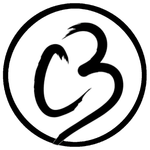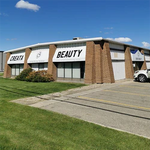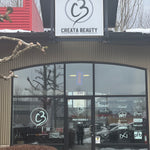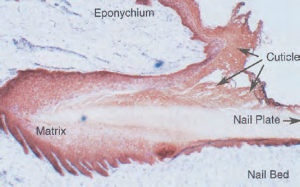.
If you asked me, “Doug, what part of the natural nail would you most want to be?” I would never reply, “the cuticle.” I’d never want to be a cuticle! Why you ask? Because, the poor cuticle is misunderstood by almost everyone! Think about it and you’ll see what I mean. During the first part of the manicure, the “cuticle” is being gently massaged with a wonderful smelling “cuticle cream,” it’s being softened, moisturized, pampered and well cared for, never cut, kept soft, smooth and clean as can be. Sounds pretty good so far, doesn’t it? But, just wait.
During the next step of the manicure or pedicure we apply cuticle remover to break down the cuticle tissue, softening it for quick and easy removal from the nail plate. We strip it away to ensure the nail polish or artificial nail will have a clean surface for proper adhesion. Wait a minute! Should we pamper the cuticles or remove them from the nail plate? How can we do both? That just doesn’t make any sense at all! So what’s wrong with these two scenarios?
The reason for this perplexing situation is clear; the problem is the incorrect usage of professional terminology. Being an American, I may use some words differently to you, but there are several words that everyone in the professional nail industry should always use correctly. One of those words is “cuticle.”
Just what is the cuticle? If you ask different people, you will get different answers. But, I believe all nail professionals should be able to properly identify the cuticle. It’s important to realize that the living skin at the base of the nail plate is not the cuticle. This skin is called the eponychium, even though it’s usually the first place
people will point to when asked to identify the cuticle. It is also important to know that the cuticle is made entirely of dead skin. In other words, any skin that’s still alive cannot be the cuticle.
It’s not correct to call cuticle tissue “ptergyium,” since that is a medical word for abnormal skin growths stretched into a triangular or wing-like shape. Nail pterygium can occur and may be a serious disorder, but it’s fairly unusual and occurs only under certain circumstances. For example, it is sometimes seen on seriously injured or badly burned fingers. In such cases, the eponychium remains firmly attached to the nail plate and does let go, as it normally would (to make cuticle). The natural growth of the nail plate slowly stretches the eponychium into the classic wing-like shape that shouts out, “Look at me, I’m a pterygium.” One of the most common types of pterygium is found in the eye and is usually thought to be an inherited disorder or an injury caused by caused by excessive exposure to outdoor elements.
So where is the cuticle? Here are the facts: the cuticle actually comes from the underside of the eponychium, where this living tissue presses against the newly forming nail plate (see figure 1).
Interestingly, the cuticle is one of the stickiest tissues on theentire body. Imagine that! The cuticle tissue is so sticky, it tightly bonds to the freshly created, growing nail plate, making it rather difficult to remove. As the natural nail plate continues to grow, it pulls off a thin layer of skin, detaching it from the underside of the eponychium and dragging it away. In other words, the detached dead tissue rides on the nail plate, appearing to grow from under the living skin. This thin layer of colorless tissue is the cuticle (see Figure 2). The underside of the eponychium is constantly shedding thin layers of this colorless tissue. Why? This shed skin creates a very important barrier that helps prevent infectious organisms from invading the nail matrix area, the birthplace of the nail plate. Infections of the nail matrix can lead to deformity or loss of the nail plate, so nail professional must always carefully work in this area, to prevent this from occurring. Carefully handling the eponychium and cuticle is very important to prevent infections and keep the natural nail plate healthy.

- A cross-section of an actual human finger nail, showing the cuticle attached to the nail plate and being pulled from the underside of the eponychium.
During a properly performed manicure or pedicure, the eponychium is softened, moisturized and then very gently pushed back to expose the dead cuticle tissue on the nail plate for easier removal. Always take proper care while working in this sensitive area. Improperly performed, this part of the service can cause problems for clients. For example, applying artificial nail products over the cuticle will block adhesion and cause the artificial nail to lift from the natural nail plate. The same is true for nail polish. Many wasted hours of valuable time are lost performing repairs caused by careless removal of the cuticle. Also, since improper removal of the cuticle can lead to potentially serious nail infections or deformities, it is very important to avoid overly aggressive removal techniques and never dig back underneath the living skin. It is acceptable to gently push back the living eponychium, but do not place any instrument underneath the skin itself, since this can damage this critical protective barrier, thereby increasing the risk of injury and/or infection.
Sharp instruments can inflict serious injury, so avoid them during manicures and pedicures. It is important to remember, never cut any living skin around the nail plate. This practice can lead to a wide variety of infections, including warts. Finally, follow manufacturer's directions when using cuticle removers, taking care to use them only as directed. These products can be potentially irritating and may cause skin and nail damage if not used correctly. Always remember, it is important for nail professionals to respect both the cuticle and eponychium. Together, they form an important barrier that helps to protect the nail matrix.
 s. It’s up all of us to understand and use proper terminology, if we expect to establish ourselves as true professionals. So, next time you’re applying that oil or lotion and pushing back the skin, stop and think… are you working on the eponychium or the cuticle?
s. It’s up all of us to understand and use proper terminology, if we expect to establish ourselves as true professionals. So, next time you’re applying that oil or lotion and pushing back the skin, stop and think… are you working on the eponychium or the cuticle?






